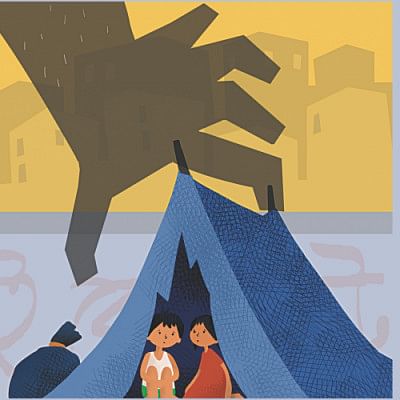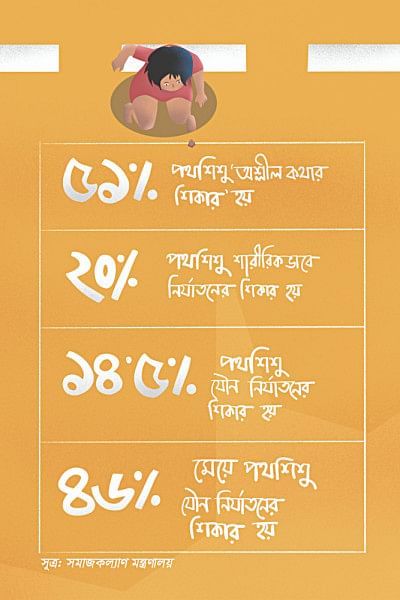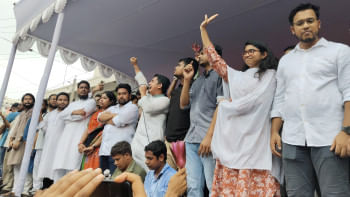ON THE STREETS

For children on the streets, exploitation, abuse, and neglect is just an everyday affair. And overlooking them, is a part of our everyday affair.
At this very moment, the government has no statistics on the number of homeless children, let alone the number who are being exposed to violence, sexual abuse, drug addiction, corporal punishment, malnutrition, and lack of shelter on a regular basis.
Although Article 28 (1) of the constitution mentions that the state shall not discriminate against any citizen on grounds only of religion, race, caste, sex or place of birth, these abandoned street children are denied their rights to a safe and healthy childhood.

Sexual abuse is currency
The story of 15-year-old Suma from Netrakona perhaps best depicts the nature of sexual abuse one faces on the streets. After her parents separated, her mother came to Dhaka and married another man in the Kawran Bazar area. Although Suma had been living with her grandmother in their village, her mother brought her to Dhaka when she was 12 years old and sent her to work as a domestic help in a house in Mohammadpur, in exchange for a lump sum of cash. That was the first time she experienced the sexual harassment of men.
According to Suma, her employer, a middle-aged businessman in Kawran Bazar, often tried to get close and touch her, talked dirty, and would use vulgar gestures. She escaped the house within a month but when she went to her mother, she was beaten up severely and disowned, now that she was a financial burden.
Suma ultimately ended up living on the streets. She soon realised that life on the streets is daunting, especially for girls her age. "I used to sleep in the Kawran Bazar area. Soon, people started inviting me to go with them in exchange for Tk 500. I've faced abusive proposals every day. I even started wearing pants and shirts like boys but people could identify me as a girl when I spoke," said Suma.
Talking to The Daily Star, Suma went on to share a horrible experience she went through in her early days on the streets. "One day, I was so hungry and I didn't have any money to buy food. I met a person and begged for money from him and he assured me that he will give me Tk 50, if I carry a load of net bags on my head and deliver that door-to-door with him. It was about evening when we finished delivering the net bags, but instead of paying me my money, he took me to a nearby narrow alley and clamped a piece of cloth on my face," explains Suma. "I could feel that I was getting weaker as he was dragging me to a building. But I was lucky as some people saw what happened and the man ran away immediately," narrates Suma.
13-year-old Munia has a similar story—her parents separating, coming to Dhaka, begging on the streets, and eventually, being physically and sexually abused by passers-by. She said girls on the streets start getting sexually abused by people they know and interact with regularly. "If you say no, you cannot live in that particular spot, because it's their area. There is not a single place that is safe for girls on the streets," she adds.
According to Mamun Bakaul, the resident social and health worker of a government-led shelter home, an overwhelming majority of street children, especially girls, face sexual harassment on a regular basis and the harassment usually starts with the person who provides them with food and shelter.
In his experience, when a girl is new on the streets, she is spotted by floating street people, who provide them food and shelter initially. This way, they become the protector of these kids. When the children start to depend on them, they control and abuse them in whatever way they want and at one point they compel them to participate in commercial sex practices, explains Mamun.
"If they resist such abuse, they are branded with a mark on a part of their body. It marks out that she was once a 'bad girl' who lives in the streets." Workers at the shelter have seen such marks on the children.

Corporal punishment an everyday affair
Apart from sexual abuse, children on the street also regularly face physical violence. The perpetrators are usually adults in the immediate community, passers-by, and ironically, law enforcers.
The man whom 10-year-old Munia called "father", as she had never known her own parents, once broke her leg when she refused to beg one day because she was unwell. "His wife and I had to hand over all the money we earned from begging all day. He used to use that to buy drugs. If we refused, we were beaten up," said Munia.
The same happened to Suma. After being disowned by her mother, she tried to survive by picking abandoned vegetable items from the vegetable trucks in Kawran Bazar and selling those in the morning the next day. "After collecting vegetables, the whole night, I could earn around Tk 500 every day. But when my mother saw me earning money, even though she disowned me, she started demanding money from me. If I refused to do the same tiring work every night, she used to beat me up mercilessly," said Suma. "There were even instances when she tied me up with a chain and beat me until I lost my senses," she adds.
The worst part of the life of many street children is punishment by the very people whose duty it is to protect them. According to several children The Daily Star spoke to, police beat them up mercilessly if they sleep in train stations.
"The night I came to Dhaka I had no place to sleep, so I slept at the Tejgaon station. I woke up to being baton charged by policemen. I learnt later that they don't allow children to sleep in the station," said Rasel, who lives on the streets.
Street children are also exploited by small business owners who employ them to sell scrap materials, popcorn, chips, flowers, tea, drugs, and more. "At first, they use children for their own benefit. Since children are happy with Tk 50-100 and three meals a day, these street vendors take advantage of this dependence and control them accordingly. Upon refusal to work further, they beat them mercilessly," said Mamun.
No room for children with addiction
According to a European Union-funded study released last year, 700,000 Bangladeshi children live on the streets, with a third of them in Dhaka alone. Most of them are addicted to drugs as they live without any sort of support—family, love or care.
Most other street children are addicted to various kinds of drugs, primarily glue used for repairing leather or rubber products. Colloquially known as "dandy", this drug is popular as it is cheap; the children also consume cannabis, cigarettes, and sometimes, yaba.
The children with addiction also work as couriers between dealers and buyers. According to 12-year-old Rakib, who lives in Kawran Bazar, every time they supply to buyers, they get around Tk 20-50. "A few customers would even give us a couple of baba (yaba) pills as tips," laughs Rakib.
Wahida Banu, executive director of the national child rights organisation Aparajeyo Bangladesh, said the few organisations that work on drug rehabilitation of children are for those from well-off backgrounds who can afford long-term treatment. In comparison, there are very few NGOs that work for street children.
Although the government has two shelters in Kawran Bazar and Kamlapur, housing approximately 250 street children, there is no such rehabilitation centre for those who are addicted to dandy and other drugs. Although the two shelters regularly go to the stations to ask children whether they want to come live in the shelter, children who live with addictions rarely stay there, say shelter workers. The children and the staff both said that the children eventually leave because they cannot beat the craving.
Abul Hossain, project director of MoWCA's Street Children Rehabilitation Programme, informed this correspondent that currently the ministry doesn't have any programmes that address or rehabilitate street children with addictions. "Although our ministry looks after issues related to women and children, we don't have any mechanism to introduce a large-scale service for children with addiction," he said. "But we can coordinate with the Department of Narcotics Control," he added.
"Since the management of children with addictions is different, it creates risk if they live together with a healthy child. They can be referred to the Central Drug Addiction Treatment Centre in Tejgaon which has been offering 10 beds for the treatment for the children with addictions since 2013," he added.
But those 10 beds of the Central Drug Addiction Treatment Centre (CDATC) are failing to treat street children with addictions, as there's no system in place to send the children there. Between 2016 and 2018, under an MoU with CDATC, Dhaka Ahsania Mission used to send children there for rehabilitation but there's no such arrangement at the moment.
"We don't have any designated staff here for this matter and this is not our responsibility either. The narcotics department's staff sometimes bring children here and after giving necessary treatment, we send them to government shelters," said Syed Imamul Hossain, chief consultant of CDATC.
Prof Dr Arup Ratan Chowdhury, founder of the Association for the Prevention of Drug Abuse (MANAS), said "Since their addiction is not as severe as adults, they can be treated without any detoxification. They just require isolated rehabilitation and psychological counselling by clinical psychologists."

 For all latest news, follow The Daily Star's Google News channel.
For all latest news, follow The Daily Star's Google News channel. 



Comments